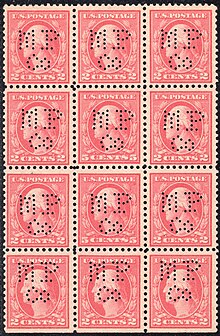Perforation (philately)
The (company) punching of stamps was a security measure against theft of stamps by the workforce. In English usage and partly also in German they are called Perfin , from the English abbreviation “ Perf orated In itials”, which means something like: perforated initials. A distinction is made between two types: on the one hand, official perforation by authorities , on the other hand, non-official perforation, e.g. B. by companies. In both cases a grid of dots was punched into the image of the stamp, changing the appearance of the stamp.
The stamp was not canceled by the perforation , but only made identifiable for limited use. Usually the first letters of the company or symbols were used for this. Perforations were mainly used as protection against theft. Companies, agencies and authorities with a larger supply of postage stamps marked their stamps in this way. This made them unusable for the private use of employees and employees.
Official holes made by the authorities meant that they were used for official purposes, with official stamps sometimes being used instead . In Germany z. For example, Bavarian postage stamps between 1912 and 1915 were converted into official stamps for the Bavarian railway authorities with an embossed "E" , Australian stamps received the perforation "OS" for " Official Stamp ". This perforation (OS) was later replaced by a corresponding stamp.
The idea of punching stamps goes back to the Englishman Joseph Sloper , who in 1867 applied for a patent for a special punching machine and received approval from the post office. In 1877 this method was also used in Germany and was in use there until the 1950s. Today Perfins are no longer allowed in most postal areas, including Germany. Instead, indicia are now mostly used for franking.
literature
- Gerd H. Hövelmann: "POL" perforations by the police authorities. In: philately issue no. 389 of November 2009, pp. 28–30
- Rainer von Scharpen: To protect against theft. (Cover story) In: Deutsche Briefmarken-Zeitung issue No. 24/2013, pp. 16–20
- Deutsche Briefmarken-Zeitung issue no. 11/2014, pp. 24–27
- Martin Baer: SWISS PERFINS catalog , December 2014
Individual evidence
- ↑ a b c mint never hinged - Das Philatelie-Journal der Deutsche Post, July / August 2009, p. 33
- ^ Large encyclopedia of philately. 1st edition. A. Kurzl Verlag, Munich 1923, p. 676; with reference to: Wiener Illustrierte Briefmarken Zeitung 1876, p. 47
